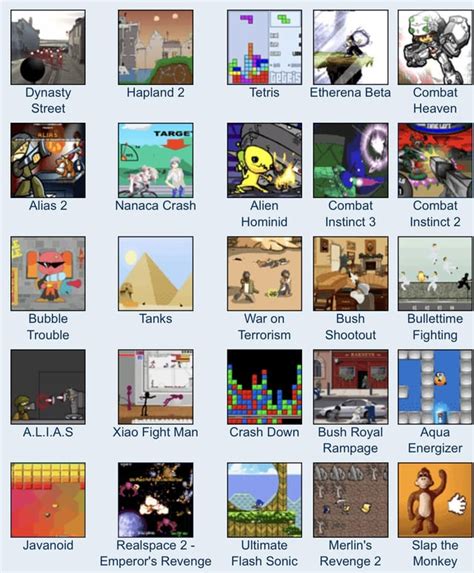Breaking News


Popular News


Explore the rise and fall of Flash games, its impact on gaming culture, and the transition to mobile gaming. A nostalgic look back at its legacy.Flash games hold a special place in the hearts of many online gamers. From simple, addictive puzzles to immersive multiplayer experiences, these games defined an era of internet entertainment. In this blog post, we’ll take a nostalgic look back at the rise and fall of flash games, from their humble beginnings to their lasting impact on gaming culture. We’ll explore the golden age of flash games, the challenges and limitations they faced, and their eventual transition to mobile gaming. Additionally, we’ll examine their legacy and the nostalgia they still evoke in those who fondly remember spending hours playing these games. Join us as we reminisce about the heyday of flash games and the enduring mark they’ve left on the world of online gaming.
Contents

Flash games were the gateway for many gamers into the world of online gaming. In the early 2000s, these games took the internet by storm, offering a wide range of genres and styles to appeal to players of all ages. Whether you were into puzzle games, action games, or even strategy games, there was always something for everyone in the world of flash games.
One of the main appeals of flash games was their accessibility. Unlike traditional PC games, flash games could be played right in your web browser without the need for installation or expensive hardware. This made them a popular choice for casual gamers looking for a quick and easy gaming experience. Additionally, the simplicity of many flash games made them easy to pick up and play, attracting a wide audience of players.
As the popularity of flash games grew, so did the community surrounding them. Websites like Newgrounds and Kongregate became hubs for flash game enthusiasts, offering a platform for developers to showcase their creations and for players to discover new titles. This sense of community and creativity further fueled the rise of flash games and solidified their place in gaming culture.

During the early 2000s, Flash games experienced a surge in popularity, marking what many consider to be the golden age of browser-based gaming. These games were accessible to anyone with an internet connection and a web browser, providing hours of entertainment without the need for expensive consoles or high-powered computers. From simple puzzle games to complex RPGs, Flash games offered a diverse range of experiences for players of all ages.
One of the key factors contributing to the golden age of Flash games was the ease of development and distribution. With the Flash platform, game developers could create and publish their games quickly and easily, leading to a vast library of titles for players to choose from. This open accessibility allowed for indie developers to thrive, resulting in a wide variety of unique and innovative games that may not have found a platform elsewhere.
Furthermore, the community aspect of Flash games played a significant role in their success. Online forums and websites dedicated to sharing and discussing these games brought players together, fostering a sense of community and collaboration. Players could easily share their favorite games with friends or discover hidden gems recommended by fellow enthusiasts, creating a rich and interconnected gaming culture surrounding Flash games.
While the golden age of Flash games may have come to an end with the decline of the Flash platform, its impact on the gaming industry and pop culture still resonates today. The legacy of Flash games lives on in the hearts of players who fondly remember the hours spent exploring virtual worlds and overcoming digital challenges, making it a truly timeless era in the history of gaming.

Flash games have had a significant impact on gaming culture since their rise to popularity in the early 2000s. These games provided a new and accessible form of entertainment for people of all ages, leading to a shift in the way that many individuals interacted with and enjoyed video games. The wide variety of flash games also contributed to the diversification of the gaming community, as individuals were able to explore new genres and styles of gameplay that were not as prevalent in traditional console or PC games.
Furthermore, flash games helped to cultivate a sense of community and collaboration within the gaming world. With the ability to easily share and distribute flash games online, players were able to connect with one another and discuss their experiences with different titles. This led to the development of online communities and forums dedicated to flash gaming, further enhancing the social aspect of gaming culture and creating a space for individuals to bond over their shared love of these games.
Flash games also played a key role in shaping the way that many people view and interact with technology. These games were often simple to play and required minimal technical knowledge, making them accessible to a wide audience. As a result, flash games helped to introduce many individuals to the world of gaming and technology, sparking an interest that would continue to influence their lives and interests for years to come.
In conclusion, the impact of flash games on gaming culture cannot be overstated. These games introduced a new form of entertainment to a diverse audience, fostered a sense of community and collaboration, and helped to shape the way that many individuals engage with technology. The legacy of flash games continues to be felt today, as many individuals look back on these games with nostalgia and appreciation for the role they played in shaping the gaming landscape.

One of the biggest challenges of developing and playing Flash games was the limitations of technology. In the early days of Flash gaming, internet speeds were much slower than they are today, which meant that games had to be designed with small file sizes in mind. This limited the complexity and scope of games that could be created, and often resulted in simplistic graphics and gameplay.
Another challenge was the lack of standardization in the development process. Different web browsers and operating systems often displayed Flash games differently, leading to compatibility issues. This made it difficult for developers to ensure that their games would work for all players, regardless of their setup.
Additionally, the limitations of the Flash platform itself posed challenges. The software was not well-suited for handling complex physics or 3D graphics, which limited the types of games that could be created using Flash. This meant that many popular game genres, such as first-person shooters or realistic racing games, were difficult to replicate with the technology available.
Despite these challenges, developers and players alike found ways to work around the limitations of Flash gaming, leading to the creation of countless innovative and enjoyable games.

With the advancements in technology and the widespread use of smartphones, the gaming industry has experienced a significant shift towards mobile gaming. As mobile devices became more powerful and portable, it paved the way for a new era of gaming where people could play their favorite games on the go. This transition has revolutionized the way people consume and interact with games, creating a whole new market for developers and players alike.
One of the key factors driving the transition to mobile gaming is the convenience and accessibility it offers. Unlike traditional gaming platforms such as consoles or PCs, mobile games can be played anytime, anywhere, providing a quick and easy way for people to entertain themselves. This has made gaming more inclusive and appealing to a wider audience, breaking down the barriers of entry that were present in the past.
Furthermore, the rise of mobile gaming has also had a profound impact on the gaming industry as a whole. Developers are now focusing more on creating games specifically tailored for mobile devices, leading to a diverse range of gaming experiences that cater to different preferences and playstyles. This has led to the democratization of gaming, allowing indie developers and smaller studios to thrive in the mobile gaming market and compete with larger, more established companies.
However, despite the many benefits of mobile gaming, it also comes with its own set of challenges and limitations. The transition from traditional gaming platforms to mobile devices has raised concerns about the quality and depth of gaming experiences, as well as the prevalence of microtransactions and in-app purchases. As the industry continues to evolve, it’s important to find a balance between accessibility and monetization in order to ensure that mobile gaming remains a sustainable and enjoyable form of entertainment for players.

Flash games may be a thing of the past, but their legacy and the nostalgia they evoke remain very much alive in the gaming community. For many gamers, especially those who grew up in the 1990s and early 2000s, Flash games were a formative part of their gaming experience. These simple, yet addictive games were often a source of entertainment and escape, providing hours of fun during lunch breaks or after school.
Despite the limitations of Flash technology, the legacy of these games lives on. The impact they had on gaming culture cannot be understated. Many popular indie games and mobile games today can trace their roots back to the creativity and innovation that characterized the Flash game era. The influence of these games can be seen in the design, mechanics, and storytelling of modern games, proving that their impact was enduring.
Looking back, it’s impossible not to feel a sense of nostalgia for the golden age of Flash games. The simplicity of the graphics and gameplay, the quirky humor, and the unique charm of these games continue to hold a special place in the hearts of many gamers. Nostalgia for Flash games has even led to dedicated communities and websites that preserve and celebrate these classic titles, ensuring that their legacy will never be forgotten.

What are Flash games?
Flash games are video games that were developed using Adobe Flash and were playable on web browsers.
Why were Flash games so popular?
Flash games were popular because they were easily accessible, free to play, and offered a wide variety of genres and gameplay styles.
What led to the decline of Flash games?
The decline of Flash games was primarily due to the phasing out of Adobe Flash Player by major web browsers and the shift towards more advanced technologies.
Are there any ways to still play Flash games?
While Adobe Flash Player has been discontinued, some websites and projects offer emulators and downloadable files to continue playing Flash games.
What is the impact of the decline of Flash games on the gaming industry?
The decline of Flash games has led to a shift towards HTML5 and other technologies, as well as the preservation of old Flash games through emulation and archiving efforts.
Do people still have nostalgia for Flash games?
Yes, many people who grew up playing Flash games still have nostalgia for them and reminisce about the simpler times when these games were a big part of their online experience.
What is the legacy of Flash games in the gaming world?
The legacy of Flash games lies in their influence on indie game development, the rise of casual gaming, and the inspiration they provided to a generation of aspiring game developers.